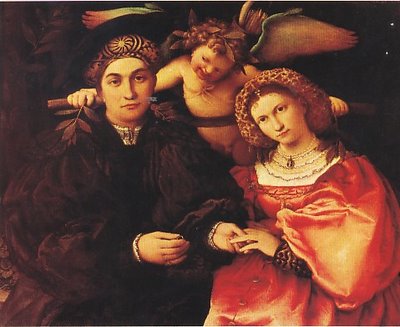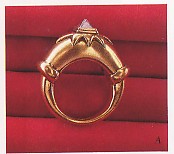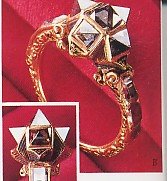The Gift of LOVE...
....the 15th Century

The giving of a ring has long been the traditional way to seal a promise.
The promise to marry is perhaps the most sacred of pledges and is therefore marked by some very special rings. Since the 15th century diamond rings,
endurance, have been the choise of those who can afford them.
This beautiful painting depiicts the marriage of Messer Marsilio and his bride by Lorenzo Lotto from the Prado Gallery, Madrid.
It records the significant moments of the placing of the ring watched over by the loving gaze of Cupid. The man and the woman stare at us, the viewers, the witnesses to their vows.

In medieval days, the rich were married with rings set with gems. By the 15th century the diamond, then the acknowledged symbol of conjugal faithfulness because of its resistance to fire and steel, became part of the use ritual of weddings. Indeed, the use of a diamond ring for betrothals seem to have been general towards the end of this century. A letter written to Mary of Burgundy declares: "At the betrothal, your Grace must have a ring set with a diamond and also a gold ring."

During this time, the famous was the Sforza Marriage Ring, in Italy - 1475.
Sforza Marriage ring. Italy 1475.
It was the simple early Renaissance style ring copied from an old manuscript in the Vatican. It documents an important marriage in the Sforza family in the 15th century. The natural rough diamond does not sparkle like today's polished jewels but its hardness symbolises the durability of the marriage.
At that time, the diamond was used in its natural crystalline structure. The octahedral or eight-sided formation, like two pyramids joined at the base, was mounted with the lower pyramid completely hidden in the ring setting and upper half rising proud of it. Light reflected from all four sides of this exposed upper point.
The stucture of these diamonds mirrors the symbolism of the Egyptian pyramids. It was often believed that buried beneath the pyramid was a lower half - the evil half - of exactly the same shape and proportions.
Far from being constrained by the heavy, closed mounts, the late medieval goldsmiths used imagination and romantic vision in their designs to enhance the status of the diamond. Hog-back diamonds were introduced and composed into even more eloborate settings, for example, rosette, letter of the alphabet and the Virgin's symbol, the fleur-de-lys, an appropriate emblem for an innocent young bride.
At the same time, posies(meaning little poems) were inscibed on the hoops of rings, often hidden inside. These secret words of love might be decorated with roses warmed by sun-rays, allpicked out in vivid enamels. There are many examples of such messages on rings. Anne of Cleves, who married Henry VIII inthe 16th century, had this optimistic inscription on her wedding ring: "God send me well to kepe." But, although so prevelant in the 15th and 16th century rings, loving and pious inscriptions had also been popular in antiquity. An inscription cut into a Greek betrothal ring about 400 BC bears the single word, "Honey."
By the end of the 15th century, the first real breakthrough in cutting techniques emerged and in so doing opened up public opinion to a totally new shape: the table-top cut. Here the diamond's pyramidal point is rubbed flat with diamond dust.. . the very first step towards modern polishing, the first turn of the key in unlocking the diamond's hidden fire and brillance.
Then, the table-top cut became an important feature of the 16th century diamond rings.
The said ring which relates Mary of Burgundy and Maximilian of Austria is in the Kunsthistorisches Museum in Vienna, believed to be the original gift of love. Hogback diamonds, the forerunner of today's baguette, are arranged in the shape of the Gothic letter 'M', alluding to the Virgin Mary, and the permenant union of Mary and Maximilian's marriage.
"At the betrothal, your Grace must have a ring set with a diamond and also a gold ring. Moreover, in the morning your Grace must bestow upon the bride some costly jewels"
From a letter written from Ghent on 30th July 1477 by Dr. Wilhem Moroltinger to Archduke ( later Emperor ) Maximilian just before his betrothal to Mary of Burgundy, daughter of Chales the Bold. This is one of the earliest known examples of diamond rings given specially to seal engagement.
The comparative rarity of the diamond ring presented a challenge to the 16th century goldsmiths whose skills, encouraged by royal patronage, reached a peak of perfection. The exquisite designs, with their chased hoops, shoulders of sculptural or architectural form decorated with soft enamels combined with pointed or table-cut stones, have never been surpassed. the goldsmith also devised a new way to show off the diamond: a silver foil which lined the setting, accentuating the stone's pure, white light.
The symbolic values of the diamond, allied to its sheer beauty, made it highly priced for royal betrothals and royal weddings. The wedding ring of Duke Albrecht V of Bavaria was set with sixteen small diamonds in the form of rosette, a quite extraordinary achievement of the 16th century polishing and setting. One of the three rings used at the marriage of Mary Stuart and Henry Darnley at Holyrood in 1565 was enamelled red, and set with a diamond. At a time when she feared death in childbirth, Mary bequeathed this ring to her husband, poignantly recalling that it was "the ring he had wed her with." Again, when Mary's son, James I, married Anne of Denmark in 1589, diamonds were chosen for the wedding ring which was "of gold enamelled and sett with fyve diamontes"
 This extraordinary "hedgehog" like ring holds five natural diamond crystals in a perfectly symmetrical moun that echoes the natural shape of the diamonds. It gives the impression of anenormous and complex stone, with light flashing in all directions. The scrolled shoulders are set with a table-cut ruby adding a final touch of opulence.
This extraordinary "hedgehog" like ring holds five natural diamond crystals in a perfectly symmetrical moun that echoes the natural shape of the diamonds. It gives the impression of anenormous and complex stone, with light flashing in all directions. The scrolled shoulders are set with a table-cut ruby adding a final touch of opulence.A royal renegade who set her face against a diamond wedding ring was Mary Tudor. For her marriage to Philip II of Spain in 1554 she chose, instead, a plain gold band. " Maydens were so married in olde tymes," she tartly remarked. However, ironically, years before this when she was just two years old and unable to state her views, the young Princess Mary had been married by proxy to the infant Dauphin of France. Cardinal Wolsy then placed a very small ring, set with a large diamond, upon the child's finger...

0 Comments:
Post a Comment
<< Home